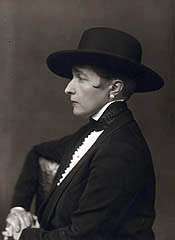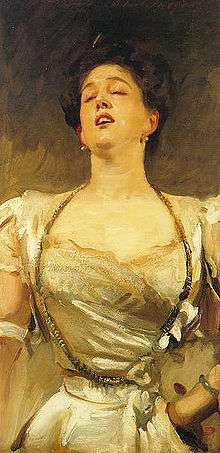Radclyffe Hall
| Radclyffe Hall | |
|---|---|
 | |
| Born |
Marguerite Radclyffe Hall 12 August 1880 Bournemouth, England, UK |
| Died |
7 October 1943 (aged 63) London, England, UK |
| Occupation | Novelist, poet, short story writer |
| Period | 1906–1936 |
|
| |
| Signature |
|
Radclyffe Hall (born Marguerite Radclyffe Hall on 12 August 1880 – 7 October 1943) was an English poet and author, best known for the novel The Well of Loneliness. The novel has become a groundbreaking work in lesbian literature.
Life
Marguerite Radclyffe Hall was born in 1880 at "Sunny Lawn", Durley Road, Bournemouth, Hampshire (now Dorset),[1] to a wealthy philandering father and a quarrelsome mother. Her stepfather was the professor of singing Albert Visetti, whom she did not like and who had a tempestuous relationship with her mother.[2][3] Hall was a lesbian[4] and described herself as a "congenital invert", a term taken from the writings of Havelock Ellis and other turn-of-the-century sexologists. Having reached adulthood without a vocation, she spent much of her twenties pursuing women she eventually lost to marriage.


In 1907 at the Homburg spa in Germany, Hall met Mabel Batten, a well-known amateur singer of lieder. Batten (nicknamed "Ladye") was 51 to Hall's 27, and was married with an adult daughter and grandchildren. They fell in love, and after Batten's husband died they set up residence together. Batten gave Hall the nickname John, which she used the rest of her life.[5] Under Batten's influence, Hall converted to Roman Catholicism; Joanne Glasgow writes that for Hall and other lesbians of the early twentieth century, such as Alice B. Toklas, the church's erasure of female sexuality offered a cover for lesbianism.[6]
In 1915 Hall fell in love with Mabel Batten's cousin Una Troubridge (1887–1963), a sculptor who was the wife of Vice-Admiral Ernest Troubridge, and the mother of a young daughter. Batten died the following year, and in 1917 Radclyffe Hall and Una Troubridge began living together.[7] The relationship would last until Hall's death. In 1934 Hall fell in love with Russian émigré Evguenia Souline and embarked upon a long-term affair with her, which Troubridge painfully tolerated.[8] She became involved in affairs with other women throughout the years.[9]
Last years/death
Hall lived with Troubridge in London and, during the 1930s, in the tiny town of Rye, East Sussex, noted for its many writers, including her contemporary the novelist E.F. Benson. Hall died at age 63 of colon cancer, and is interred at Highgate Cemetery in North London.
In 1930, Hall received the Gold Medal of the Eichelbergher Humane Award. She was a member of the PEN club, the Council of the Society for Psychical Research and a fellow of the Zoological Society.[10] Radclyffe Hall was listed at number sixteen in the top 500 lesbian and gay heroes in The Pink Paper.[11]
Novels
Hall's first novel was The Unlit Lamp, the story of Joan Ogden, a young girl who dreams of setting up a flat in London with her friend Elizabeth (a so-called Boston marriage) and studying to become a doctor, but feels trapped by her manipulative mother's emotional dependence on her. Its length and grimness made it a difficult book to sell, so she deliberately chose a lighter theme for her next novel, a social comedy entitled The Forge.[12] While she had used her full name for her early poetry collections, she shortened it to M. Radclyffe Hall for The Forge. The book was a modest success, making the bestseller list of John O'London's Weekly.[13] The Unlit Lamp, which followed it into print, was the first of her books to give the author's name simply as Radclyffe Hall.[14]
There followed another comic novel, A Saturday Life (1925), and then Adam's Breed (1926), a novel about an Italian headwaiter who, becoming disgusted with his job and even with food itself, gives away his belongings and lives as a hermit in the forest. The book's mystical themes have been compared to Hermann Hesse's Siddhartha.[15] It sold well, was critically acclaimed, and won both the Prix Femina and the James Tait Black Prize, a feat previously achieved only by E. M. Forster's A Passage to India.[16]
The Well of Loneliness
Hall's best-known work was The Well of Loneliness, the only one of her eight novels to have overt lesbian themes. Published in 1928, The Well of Loneliness deals with the life of Stephen Gordon, a masculine lesbian who, like Hall herself, identifies as an invert.
Although The Well of Loneliness is not sexually explicit, it was nevertheless the subject of an obscenity trial in the UK, which resulted in all copies of the novel being ordered destroyed. The United States allowed its publication only after a long court battle. It is currently published in the UK by Virago, and by Anchor Press in the United States. The Well of Loneliness was number seven on a list of the top 100 lesbian and gay novels compiled by The Publishing Triangle in 1999.[17]
Later novels
An anonymous verse lampoon entitled The Sink of Solitude appeared during the controversy over The Well. Although its primary targets were James Douglas, who had called for The Well's suppression, and the Home Secretary William Joynson-Hicks, who had started legal proceedings, it also mocked Hall and her book. One of the illustrations, which depicted Hall nailed to a cross, so horrified her that she could barely speak of it for years afterward. Her sense of guilt at being depicted in a drawing that she saw as blasphemous led to her choice of a religious subject for her next novel, The Master of the House.[18]
At Hall's insistence, The Master of the House was published with no cover blurb, which may have misled some purchasers into thinking it was another novel about inversion. Advance sales were strong, and the book made #1 on the Observer's bestseller list, but it received poor reviews in several key periodicals, and sales soon dropped off.[19] In the United States reviewers treated the book more kindly, but shortly after the book's publication, all copies were seized—not by the police, but by creditors. Hall's American publisher had gone bankrupt. Houghton Mifflin took over the rights, but by the time the book could be republished, its sales momentum was lost.[20]
The Girls of Radcliff Hall
The British composer and bon-vivant Gerald Tyrwhitt-Wilson, 14th Baron Berners, wrote a roman à clef girls' school story entitled The Girls of Radcliff Hall, in which he depicts himself and his circle of friends, including Cecil Beaton and Oliver Messel, as lesbian schoolgirls at a school named "Radcliff Hall". The novel was written under the pseudonym "Adela Quebec" and published and distributed privately; the indiscretions to which it alluded created an uproar among Berners's intimates and acquaintances, making the whole affair highly discussed in the 1930s. Cecil Beaton attempted to have all the copies destroyed.[21][22][23] The novel subsequently disappeared from circulation, making it extremely rare. The story is, however, included in Berners' Collected Tales and Fantasies.
Works
Novels
|
Poetry
|
Further reading
- Una Troubridge (1961): The Life and Death of Radclyffe Hall (London: Hammond). 2008, Hesperides Press: ISBN 978-1443725422
- Lovat Dickson (1975): Radclyffe Hall at the Well of Loneliness: A Sapphic Chronicle (HarperCollins). ISBN 978-0002112352
- Michael J.N. Baker (1985): Our Three Selves. The Life of Radclyffe Hall (New York: William Morrow). ISBN 978-0688043858
- Sally Cline (1999): Radclyffe Hall: A Woman Called John (Overlook Press). ISBN 978-0879518318
- Diana Souhami (1998): The Trials of Radclyffe Hall (London: Weidenfeld & Nicolson). ISBN 978-0297818250
References
- ↑ Baker p 7
- ↑ Laura Seddon, British Women Composers and Instrumental Chamber Music in the Early Twentieth Century, Routledge (2013) - Google Books p158
- ↑ Radclyffe Hall Biography - Your Dictionary
- ↑ Glagow, Joanne (2002). "Hall, Radclyffe". glbtq.com. Retrieved 5 November 2007.
- ↑ Cline, pp 58–67.
- ↑ Haddox, Thomas F. (2005). Fears and Fascinations: Representing Catholicism in the American South. Fordham University Press. pp. 89–90. ISBN 9780823225217.
- ↑ "Radclyffe Hall".
- ↑ Hall's letters to Souline were published in Glasgow, Joanne (ed.) (1997). Your John: The Love Letters of Radclyffe Hall. New York: New York University Press. ISBN 0-8147-3125-2.
- ↑ http://www.glbtq.com/arts/waters_e.html
- ↑ Biographical note in the Virago Press edition of The Well of Loneliness.
- ↑ The Pink Paper, 26 September 1997 edition, issue #500
- ↑ Baker, pp 152–156.
- ↑ Baker, 164.
- ↑ Baker, p 168.
- ↑ Baker, 183–186.
- ↑ Baker, pp 196–197.
- ↑ "The Publishing Triangle's list of the 100 best lesbian and gay novels".
- ↑ Baker, p 257; Cline, p 280.
- ↑ Baker, pp 275–276.
- ↑ Baker, pp 279–280.
- ↑ Florence Tamagne, "History Of Homosexuality In Europe, 1919–1939", Algora Publishing, 2004; ISBN 0-87586-356-6, p 124
- ↑ Bryony Jones, The music of Lord Berners (1883–1950): the versatile peer, Ashgate Publishing, 2003; ISBN 0-7546-0852-2, pp 9, 101, 143
- ↑ Beverly Lyon Clark, Regendering the school story: sassy sissies and tattling tomboys, Routledge, 2001; ISBN 0-415-92891-5, p 143
External links
| Wikimedia Commons has media related to Radclyffe Hall. |
- Works by or about Radclyffe Hall at Internet Archive
- Lesbian novel was 'danger to nation', guardian.co.uk; accessed 9 April 2014
- Radclyffe Hall The Knitting Circle: Literature
- Radclyffe Hall profile, Encyclopedia of Gay, Lesbian, Bisexual, Transgender, & Queer Culture
- Radclyffe Hall Collection, Photographs at the Harry Ransom Center at the University of Texas at Austin
- Radclyffe Hall and Una Troubridge: papers and research material series, collectionscanada.gc.ca; accessed 9 April 2014.